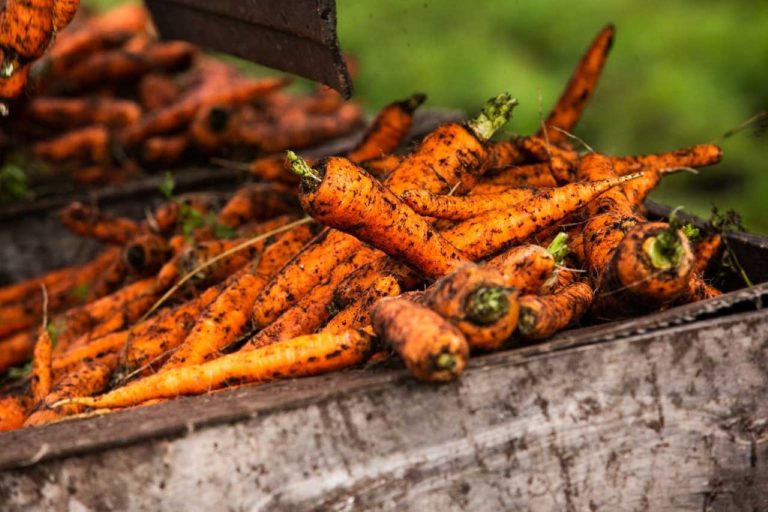As fruit and vegetable farmers wrap up their fall harvest – a time that includes picking apples, digging carrots and harvesting potatoes – we’re reminded of how fortunate we are to live in a province where we can grow wide variety of fresh produce.
As Ontarians, the abundance of local fruits and vegetables we enjoy is not just a matter of convenience, it’s also an important part of our local economy and food security.
While grocery store shelves are filled with food from around the world, we must be aware of the increasing challenges faced by global food production. Environment-related events such as increased pest pressures, droughts, floods and severe storms are putting strains on agriculture worldwide including shortages, lower quality produce, and more.
These issues highlight the need to focus on local food production. Luckily, our own farming regions in Ontario can help mitigate some of these risks, providing us with a reliable supply of fresh produce.
The COVID-19 pandemic showed just how important local food production is. With many borders closed, our reliance on imported products was put to the test, demonstrating the critical role of Ontario’s farms. Supporting local food production helps create stronger, more resilient communities and a prosperous economy.
Climate change and the environment are big concerns that emphasize the need for local food systems. Purchasing locally sourced fruits and vegetables is more sustainable by reducing carbon emissions associated with long-distance transportation. A shorter farm-to-table journey minimizes food waste and supports farmers who are increasingly adopting more environmentally friendly practices.
Ontario’s fruit and vegetable farmers are committed to sustainable farming methods, but these need to be financially viable as well. Sustainability is about more than just protecting the environment – it includes social and financial responsibilities. This means treating farm workers well, paying fair wages and ensuring the business is profitable in the present and future. Balancing these factors is essential for the success of any farm.
Reviewing and improving government business risk management programs for farmers is a critical component of this balance. These programs provide a safety net to farmers who face income and production losses from things beyond their control like weather, pests, diseases, market challenges, trade turmoil and more.
Identifying and filling gaps in these programs will make them timelier and more responsive to the growing risks posed by climate change and profitability challenges, ensuring that farmers can continue to thrive despite the unpredictable nature of agriculture.
One example is the federal Advanced Payments Program which provides short-term financing for farmers to manage seasonal cashflows and buy inputs like seeds and fertilizers. The government provides the first $100,000 of the loan interest-free, and although there have been temporary increases to this amount in recent years, it’s important that these temporary increases become permanent, especially in the current climate of high production costs resulting from inflation and government policies like the carbon tax and elevated interest rates. A permanent increase of the interest-free portion to $350,000 would be significant in ensuring farmers are able to manage their input costs until they’ve sold their crops once they’re harvested.
Another important issue is packaging. Fresh produce often requires plastic packaging – like clamshells for berries or wraps for cucumbers – to maintain food safety and freshness. While there is a push to reduce single-use plastic, it’s important to understand why plastic is necessary in fruit and vegetable production. The goal is to keep produce safe, undamaged and fresh for as long as possible, which ultimately reduces food waste. We must balance environmental concerns with the practical needs of food safety, including the use of plastic until viable alternatives exist.
It’s also important that appropriate fertilizers and crop protection products are made available to farmers. These tools are essential for maintaining healthy crops and ensuring that farmers can grow the fruits and vegetables consumers want.
This means making sure our regulatory systems and agencies are appropriately funded and can make the latest pest control tools and technologies available to Canadian farmers in a timely way. The Pest Management Centre (PMC), for example, is responsible for advancing sustainable crop protection through research, product trials and collaboration with industry stakeholders, including the farming community.
The challenge today is its declining capacity. Operating on the same fixed budget for over a decade, PMC’s ability to take on new research projects has dropped by 25% just as climate change and new and emerging pests and diseases threaten fruit and vegetable crops. The PMC received over 6,000 nominations from Canadians for crop pest management concerns in 2023 alone, yet its annual funding will cover working on about 30 of them.
By supporting local agriculture, we can strengthen our food security, promote environmental sustainability and ensure that we can keep our ability to grow our fruits and vegetables close to home. The need for fresh, local food will never parish, and together, we can build a resilient agricultural future and local food supply.


